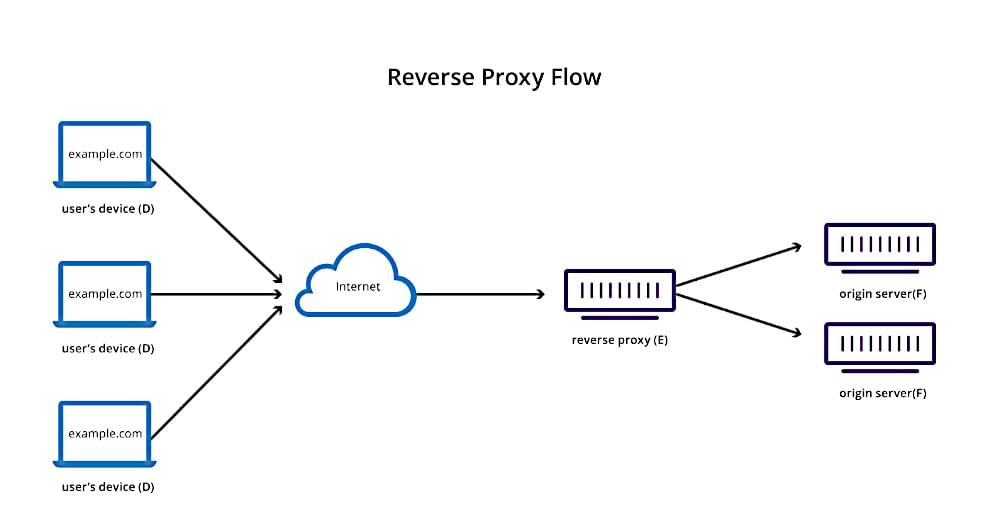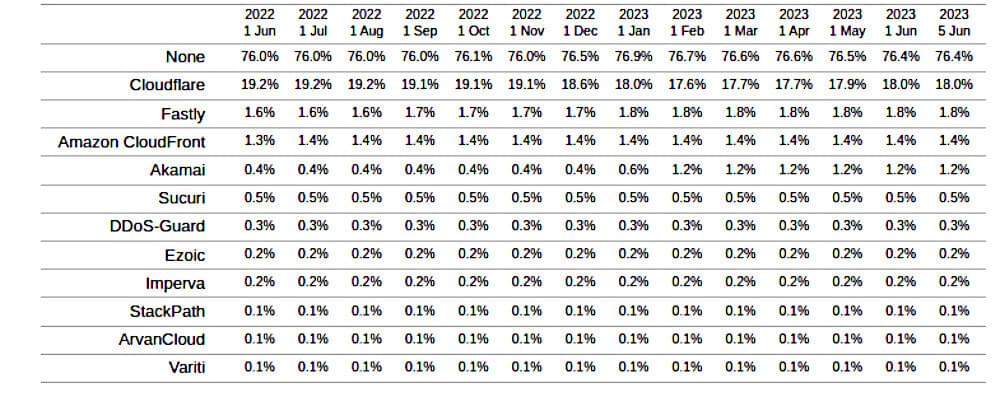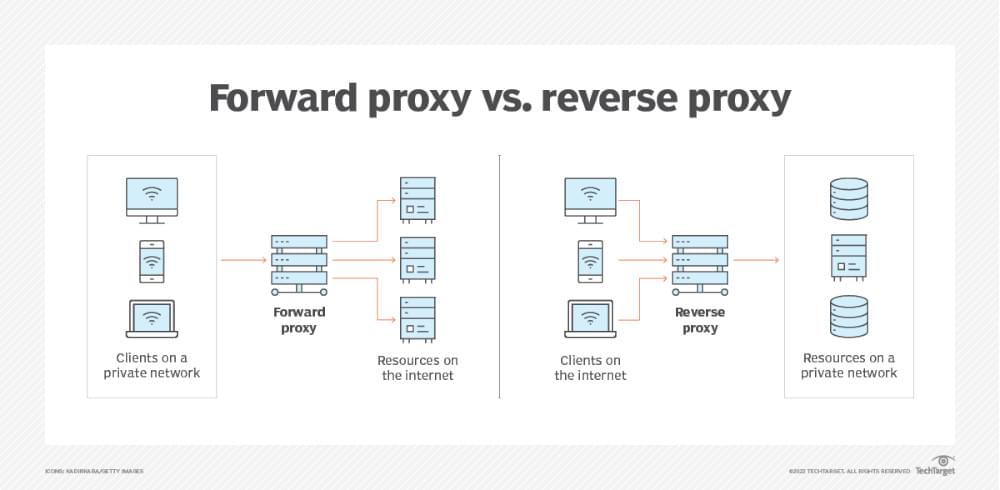We’ve discussed proxy servers and how effective they can be in safeguarding the internal network servers. People are still unclear about how reverse proxy is different. Forward and reverse proxies are very different in how they are made, their goals, and their roles in business designs.
This blog will describe the differences and similarities between forward and reverse proxy. It will also explain how they function.
What is a Reverse Proxy?
As the name implies, you can already guess what a reverse proxy is and what it does! right?
For reverse proxy meaning, Let us make it clear to you that a reverse web proxy redirects client requests to the right backend server.
A reverse proxy can monitor all incoming requests. It adds an extra layer of transparency and security. This keeps network traffic between the user and proxy servers smooth. It helps stop bad actors from misusing web servers. It does this by reducing real traffic.
For example, a reverse HTTP proxy handles client requests over HTTP. An HTTPS reverse proxy handles requests over secure HTTPS.
Reverse proxies protect the privacy of the user and the servers. They do this by preventing them from directly accessing the origin server. They also improve the security, efficiency, reliability, and speed of user requests.
Also, a reverse web proxy handles incoming website load. It does this by sharing the traffic between multiple servers. This increases the capacity to handle many user requests at a time. This prevents website crashes and downtime. You might be thinking, if one of the backend servers is overloaded or not working, then what? In that case, a reverse proxy will redirect the website load to other online servers to keep the website running.
Reverse proxy usage is far from dull. it’s incredibly popular. More than 81% of websites employ reverse proxies, indicating its widespread adoption.
How Reverse Proxy works?

Source: AImultiple
Reverse proxying involves taking requests from users. It then forwards them to the best server and the client’s request to that server. The backend server processes the request and sends the response back to the proxy server, and forwards it to the client. This process helps optimize the overall website’s performance, security, and scalability.
A load balancer in a reverse proxy setup distributes incoming requests. It sends them to backend servers to check if they are available. Then, it allocates a server to the user’s request.
Take a look at these usage patterns of reverse proxy services for websites since June 2022.

Source: W3Techs
Use cases of Reverse Proxy
Optimized performance
You might need to cache data. It’s the most common user request. This is where reverse proxies come in. They cache the picture and video content. This reduces the load on the server. It speeds up the website.
For instance, when you visit a website for the first time, a reverse proxy saves the website’s content for later use. It then sends the saved version of the web page to you the next time you visit.
Enhances Data Security
Reverse proxies can help you improve data security. They prevent data breaches by encrypting the data with protocols like SSL/TLS. We are all aware that, in 2014, Yahoo experienced the largest data breach ever recored and many user accounts were hacked.
Enforce Web Access Restrictions
If you want to limit your online access to particular websites, reverse proxies are helpful. When a staff member tries to access a website that is forbidden, the reverse proxy server will deny the request. Many companies and organizations can use reverse proxies to control and restrict access to the websites they wish.
What is a Forward Proxy?
A forward proxy is frequently mistaken for a proxy, although it’s extremely different. According to IBM, forward proxy is identified as the most common form and commonly used type of proxy server.
A forward proxy helps the user talk to the internet network. It does so on the user’s behalf. It also boosts user security within the private network. It directs traffic anonymously. Additionally, you can view restricted data using a forward proxy.
Most importantly, forward proxies develop and manage social media profiles. They control and analyze internet traffic and do much more.
How Forward Proxy works

Source: Baeldung
When a user requests from the private network, the request is routed through the forward proxy server before arriving at the web page. The data is retrieved from the website and carried back to the proxy before being forwarded to the user. This creates the impression that the proxy server is making the request. By hiding your original IP address.
Use cases of Forward Proxy
Security and Data
A forward proxy may analyze web requests. It filters data from unsafe responses and stops unauthorized access to websites. A forward proxy can also detect and interrupt network flows that send private information to the wrong recipients. A forward proxy covers an organization’s structure and its network’s weak points. It hides traffic from all websites to prevent attackers from finding and abusing it.
Avoid web filters and restriction
Websites use IP-based geolocation to find a user’s location. They use this information to limit website content. Due to this, users in specific places may only have limited access to those websites. Forward proxies help users bypass web filters by hiding their IP addresses. These filters often have anti-proxy measures. Users who use forward proxy servers can access geo-restricted websites and content. They can do so regardless of their actual location. They can also browse the internet anonymously and without being traced.
Blocking malicious entities
There are many things to safeguard behind a proxy server. This calls for an extra layer of protection. So, businesses cannot let employees access every resource and private website. For example, you may restrict access to specific websites and their content to stop your staff from accessing them. If the employee tries to access banned websites, the proxy will block their request. It will also prevent them from accessing those sites in the future.
Forward proxy vs Reverse proxy

Source: The Server Side
Until now we have seen the definitions of reverse proxy and forward proxy and how they work. We are hoping at this point that you have understood the basic difference between a proxy server and a reverse proxy.
Similarities between Reverse and Forward Proxy
Both reverse and forward proxies have a major similarity. They both aim to secure user data by adding a layer of security.
Data Caching: Both reverse and forward proxies cache data. They store data that is accessed a lot. This reduces the load on backend servers, speeds up responses, and boosts performance. These proxies allow protocol switching. They also allow terminating SSL/TLS connections.
Protocol Switching: In these proxies protocol switching and termination SSL/TLS connections is allowed.
Data Protection and Privacy: Both forward and reverse proxies provide data security and privacy secure and protect the devices on a private network. They do this by controlling and monitoring the traffic between the internal and external networks.
Now, let’s get in-depth to find out the differences between proxy and reverse proxy.
Differences between Reverse and Forward Proxy
When it comes to reverse vs forward proxy, they share some similarities. But, they also have big differences in their function and purpose.
Reverse proxies differ from forward proxies. They do so in their roles, place in the network, function, and the protection they provide to devices on private networks.
A forward proxy faces the users, acting as a mediator between them and the servers they want to access. This means that any request made by the user will go through the forward proxy first, before reaching the server. Once the data is retrieved, it is again sent to the proxy server which redirects it back to the user. A reverse proxy, on the other hand, sits in front of the servers and transfers user requests to them. A reverse proxy processes a client’s request, forwards it to another server, and redirects it back to the client.
You can manually configure a forward proxy on workplace digital devices. These devices include laptops, computers, and phones. The proxy provides secure web access. A reverse proxy, on the other hand, doesn’t need any manual settings. They work towards the same goal: securing web access and protecting users. They do so within a business architecture. Yet, both of them perform different functions and are for different users.
Reverse proxies manage communication between outside networks and backend servers. Forward proxies serve network clients mostly.
Forward proxies are for users in the network. Reverse proxies help external networks talk to backend servers.
This is further described in the table below:
| Factors | Reverse Proxy | Forward proxy |
|---|---|---|
| Traffic Direction | From user to reverse proxy server, then to the internet | User to forward proxy server, then to the internet |
| Request seems to be sent by | User | Internet |
| Communication | Indirect communication with back-end server | Indirect communication of websites with user |
| Uasge | Avoid overloading, add additional safety layers from malicious entities, caching, SSL encryption, etc | Privacy reasons, accessing geo-restricted content, web scraping, and much more. |
| Load balancing | Applicable | No |
We can say that both forward and reverse proxies are important. But, the crucial difference between them is their main goal. Reverse proxies are great for caching and reducing website load. Forward proxies are best for accessing restricted content and security.
We are confident that now you will be able to differentiate between reverse and forward proxies, as their purpose sets them apart!
Happy Reverse Proxying!
FAQs
Is reverse proxy more secure?
Yes, when compared to other proxy kinds, reverse proxies can be more secure in terms of offering extra protection and privacy. They protect your web server from attacks and breaches by hiding the server’s identity. Reverse proxies also split traffic to lower load. They manage SSL/TLS encryption, cache web content, and boost performance.
Is reverse proxy same as VPN?
No, a reverse proxy and a VPN are different. The main difference between proxy and VPN is that a reverse proxy works at the application level. It redirects client requests to the proper backend servers. A VPN works at the operational level. It creates safe and private connections between remote users and a private network.
Read more: Reverse proxy vs VPN











